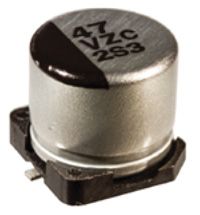Advanced capacitors based on conductive polymers maximize performance and reliability.
Capacitors may seem simple enough, but specifying them has actually grown more complex in recent years. The reason why comes down to freedom of choice. The universe of capacitors has expanded greatly over the past few years, in large part because of capacitor designs that take advantage of advances in conductive polymers.
Hybrid capacitor technology combines the performance benefits of electrolytic and polymer capacitors.
These advanced capacitors sometimes use conductive polymers to form the entire electrolyte; or the conductive polymers can be used in conjunction with a liquid electrolyte in a design known as a hybrid capacitor. Either way, these polymer-based capacitors offer a performance edge over conventional electrolytic and ceramic capacitors when it comes to:
- Electrical characteristics
- Stability
- Longevity
- Reliability
- Safety
- Life-cycle cost
The various polymer and hybrid capacitors have distinct sweet spots in terms of their ideal voltages, frequency characteristics, environmental conditions, and other application requirements. In this article, we will show you how to identify the best uses for each type of advanced capacitor. We will also highlight specific applications in which a polymer or hybrid capacitor will outperform traditional electrolytic or ceramic capacitors.
Polymer capacitor varieties
Polymer capacitors come in four main varieties, including the hybrid. Each type has different electrolytic and electrode materials, packaging, and application targets:
- Layered polymer aluminum capacitors use conductive polymer as the electrolyte and have an aluminum cathode (see Figure 1). Depending on the specific model, these capacitors cover a voltage range from 2-25 V and offer capacitances between 2.2-560 µF. The distinguishing electrical characteristic of these polymer capacitors is their extremely-low equivalent series resistance (ESR). For example, some of our SP-Cap™ polymer capacitors have ESR values as low as 3 mΩ, which is among the lowest in the industry. Packaged in a molded resin as compact surface-mount devices, these layered polymer capacitors have a low profile. As a result of the electrical and form-factor characteristics, they have applications in a variety of handheld electronic devices or other applications that require a low-profile capacitor that will not interfere with a nearby heatsink.
Figure 1: Layered polymer aluminum capacitor.
- Wound polymer aluminum capacitors are also based on conductive polymers and aluminum, but they have a wound foil structure (see Figure 2). The wound polymer capacitors cover a wider range of voltages and capacitance values than other types of polymer capacitors. Voltages extend from 2.5 to 100 V, while capacitances run from 3.3 to 2700 µF. Like the layered polymer capacitors, the wound style has extremely-low ESR values. Some of our OS-CON™ capacitors have ESR values below 5 mΩ. The wound style can also be surface mounted, though they are not quite as compact as the layered capacitors.
Figure 2: Wound polymer aluminum capacitor.
- Polymer tantalum capacitors employ a conductive polymer as the electrolyte and have a tantalum cathode (see Figure 3). They span voltages from 1.8 to 35 V and capacitances from 2.7 to 680 µF. They also have low ESR, with some of our POSCAP™ capacitors exhibiting ESR values as low as 5 mΩ. Packaged in a molded resin case, the tantalum polymer capacitors are among the most compact on the market. Our POSCAP M size measures just 2.0 by 1.25 mm. Though compact, a wide range of sizes is available for this capacitor type.
Figure 3: Polymer tantalum capacitor.
- Polymer hybrid aluminum capacitors. As their name suggests, these capacitors use a combination of a liquid and conductive polymer to serve as the electrolyte (see Figure 4) and aluminum as the cathode. Think of this technical approach as the best of both worlds: the polymer offers high conductivity, and a correspondingly low ESR. The liquid portion of the electrolyte, meanwhile, can withstand high voltages and provide higher capacitance ratings due to its large effective surface area. The hybrid capacitors offer a voltage range from 25 to 80 V and capacitances between 10 and 330 µF. At 20 to 120 mΩ, ESR values for hybrids are higher than other types of polymer capacitors, but still very low considering the higher-power applications they address.
For more detail: Understanding Polymer and Hybrid Capacitors

